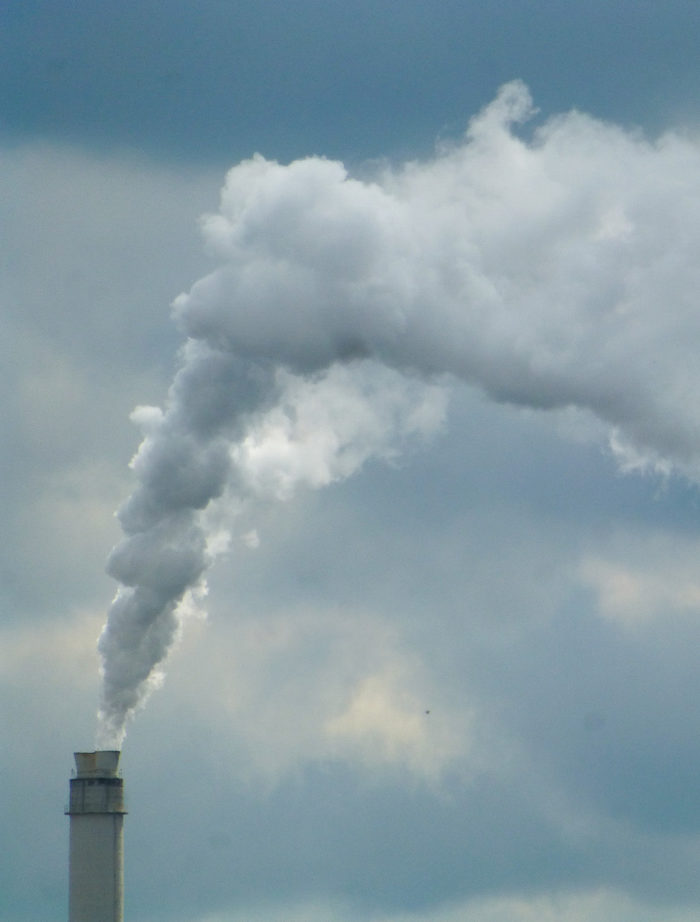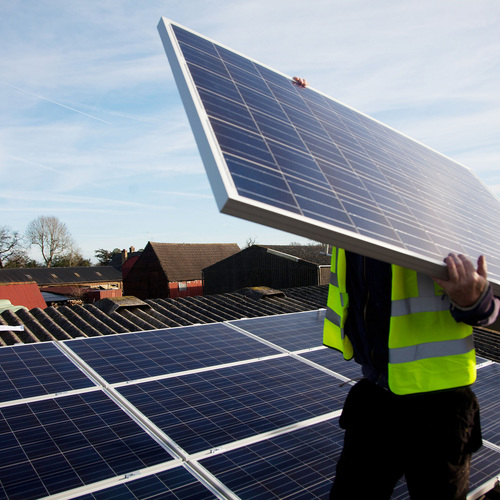
Image Credit: Mike Linksvayer via Flickr
Carbon dioxide levels top key landmark
Scientists who track the concentration of greenhouse gases in the atmosphere say the level of carbon dioxide has crossed the 400-parts-per-million threshold, perhaps permanently.
Measurements taken at the Mauna Loa Observatory in Hawaii, where global CO2 concentrations have been measured since the late 1950s, show a “saw-toothed curve” upward, reflecting seasonal ups and down in CO2. Now, scientists say, even seasonal lows are not expected to drop below the 400 ppm mark, an article in the Washington Post says.
“Our forecast supports the suggestion that the Mauna Loa record will never again show CO2 concentrations below the symbolic 400 ppm within our lifetimes,” researchers wrote.
Levels of carbon dioxide in the preindustrial atmosphere were at about 280 ppm, and as recently as 1960 were at less than 320 ppm. But more carbon dioxide is now being added to the atmosphere than natural sinks, such as plants, can handle, so CO2 levels continue to rise.
“I don’t think anything sort of special will happen just because we’re going past 400,” said Richard Betts, the lead researcher on the project. “But I do think that these numbers are important for awareness, really. … It’s a reminder of the long-term effects we’re having on the system.”
Even if industrial emissions of carbon dioxide are leveling off, CO2 levels will continue to go up because the gas is very long-lived, the study says. A reduction in CO2 would require “substantial and sustained cuts in anthropogenic emissions to near zero,” and without the development of a technology to remove carbon dioxide from the atmosphere, concentrations will continue to go up for some time to come.
LA swaps street lights for car chargers
Los Angeles spent $57 million and four years replacing sodium-vapor street lights with much more efficient LEDs, and owners of plug-in cars will be reaping the rewards.
The conversion on 4,500 miles of roads saves some $9 million a year in energy costs, and leaves power plants with excess capacity that will be used to power as many as 100 car-charging stations around the city, according to a story at Wired. “It was totally gravy,” said Mayor Eric Garcetti.
Only three charging stations have been installed so far, but another 27 are planned by the end of the year and up to 100 the following year. The 240-volt Level 2 chargers give cars up to 20 miles of range for every hour they are plugged in. Wired said officials are hoping to enable credit card payments for use of the stations so drivers don’t have to subscribe to a company such as Chargepoint, the country’s largest operator of charging points.
In order to get this municipal program off the ground, the city’s transportation department had to agree to give up some parking meter revenue, while the Department of Water and Power hooked up the chargers. The process took about 18 months.
The city now requires that half of all new light-duty city vehicles be plug-ins, which will increase to 80% in 2025, Wired said.
Canadian pitches zero-carbon project
Architect Gary Marvin says that he and his partners want to build a $600 million community of nearly 2,000 dwellings that would produce no greenhouse gas emissions.
The development is planned for a 90-acre tract just northeast of Saskatoon. Its location is just a couple of hours northwest of Regina, the city where Harold Orr and his team constructed the Conservation House, the forerunner of today’s Passive House buildings, in 1977.
The Saskatoon Star Phoenix said that Marvin isn’t asking for any special breaks for the development, which he’s calling Buffalo Ranch. He appeared before the Saskatoon city council’s planning, development, and community services committee to brief officials, but he’s already won the endorsement of the council in Corman Park where the development will be built.
Marvin envisions a community divided into 10-acre pods, each with about 200 dwellings. The community would have no interior roads, driveways, or parking lots. Instead, Marvin plans to build an underground parking facility. Wind, solar, and other renewable energy sources would supply residents with power.
Most of the superinsulated dwellings would be apartments, condos, or townhouses, with just 200 single-family homes. A full build-out would take a decade.
“It’s time to make a radical change,” Marvin said in a phone interview with the newspaper. “Let’s call it growth. Let’s call it evolution.”
Home buyers like green features
Interest on the part of home buyers in green features such as Energy Star appliances and above-code levels of insulation remained fairly consistent between 2007 and 2015, according to a survey by the National Association of Home Builders.
Construction Dive reports that 90% of the 150 home buyers participating in the survey said that Energy Star appliances were either essential or desirable. Energy Star windows weren’t far behind, with 87% of buyers wanting them. Buyers also liked the idea of getting more insulation than building codes require, but high-performance windows were the least popular feature on the list.
About half of the buyers were willing to invest in energy efficiency if it would save them $1,000 in utility bills, but only if the investments had a 20% rate of return.
A contrasting study from NAHB — the first-quarter Remodeling Market Index — showed that the importance of energy efficiency in triggering a decision to remodel has dropped since 2012. Getting new home features or increasing the value of a home continued to be more important drivers.
Other studies suggest builders and remodelers expect to be doing more sustainable building in the years ahead, and they remain convinced consumers will be willing to pay more for it.
Weekly Newsletter
Get building science and energy efficiency advice, plus special offers, in your inbox.














0 Comments
Log in or create an account to post a comment.
Sign up Log in